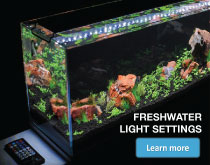Top 5 Tips for Setting up Sustainable Reef Aquarium
Today we're going to give you five tips for successfully setting up a sustainable reef aquarium. Most aquarium hobbyists really care about the environment and understand the importance of aquaculture within the marine aquarium industry and many of us have wanted to set up a completely sustainable aquarium and it's been almost reachable. It's only been in the last few years that we're really able to truly set up a sustainable reef aquarium. There's been so many advances in aquaculture, coral farming, captive breeding fish, that it's now very reachable. In this video we're going to give you five tips for setting up your first sustainable reef aquarium.
TIP#1 - Use Sustainable Reef/Live Rock
Use eco-friendly reef rock (like Real Reef Rock) and substrate versus live rock from the ocean. While many sustainable options of live rock have been available to hobbyist, it's only been in the last few years that are truly sustainable 100% eco-friendly alternative has been available to us. There are now over five types of eco-friendly rock available to aquarium hobbyist but real reef rock is still one of the favorites. Real Reef Rock is made from all the components nature uses to build a coral reef but is 100% natural marine friendly. It's made here in Southern California and real reef rock looks like typical live rock you would get from the ocean with Coralline algae already on it.
It's available in multiple shapes and sizes. They even have a branching type of rock that can be used to set up themed tanks or create unique aquascapes. Real Reef also offers a sustainable type of aragonite for your substrate so we highly suggest you check out more information by visiting their website realreefrock.com.
TIP#2 - Select a colorful community of hardy soft corals
When selecting corals for your sustainable reef, we recommend you begin with some of the hardy, easier to keep soft corals and LPS corals then slowly move into SPS corals.
Most softies and LPS corals also add the element of movement to any reef aquarium and there are many species available are completely sustainable and captive raised. Some of our favorite soft and LPS corals include Zoanthid Polyps, Xenia Polyps, Green Star Polyps and Euphyllia Corals including Torch, Hammer, and Frogspawn Corals.
TIP#3 - Research and select a community of captive bred fish.
It's now completely possible to get a whole variety of incredible looking captive bred fish for your reef aquarium. And with the advances our industry makes every year, more and more species are becoming available to us but when you're selecting the fish for your reef aquarium you're going to want to make sure that you select fish for each zone in the tank itself. For the top and middle zone of your tank, you'll want some fish that are active and don't hide a lot. Two highly recommended captive bred species are Clownfish and Cardinalfish. Clownfish are now available in an incredible variety of colors and patterns and will likely be the most active fish in your aquarium.
Cardinal fish are also a great fish to add for this zone of your reef. In the middle and lower columns, Dottybacks, Gobies and Blennies are all readily captive bred and will add incredible color and personality to your reef. If you want more information on what captive bred fish are best for your aquarium, check out our video on the Top Five Fish for Sustainable Reef Aquariums.
TIP#4 - Use a sustainable cleaner crew.
A reef cleaner crew works all day and night to keep your aquarium clean. It usually consists of snails, crabs, shrimps, urchins, many types of inverts and all they do all day long is look for food, clean, eat uneaten food and most importantly, they clean-up algae in your tank. So if you need a cleanup crew or you're wanting that cleanup crew for your sustainable reef aquarium, make sure everything's been aquacultured.
Trochus Snails are now captive bred and are one of the best algae eaters you can for your aquarium. They have voracious appetites and will clean algae from rocks, substrates and the glass panels of your aquarium. Cerith snails are an important part of any cleanup crew and captive-bred Cerith's are readily available to hobbyists. These snails are smaller than troco snails but they also have big appetites for algae, uneaten food and detritus. They are also very active at night and do a great job burrowing and stirring up your stand bed, keeping it well oxygenated. There are also many other species of aquacultured animals available for your cleanup crew including Peppermint Shrimp and Variegated Sea Urchins.
TIP#5 - Use Aquacultured macroalgae for nutrient removal.
There are many types of macroalgae that are aquacultured today and readily available to hobbyists that you can put in your tank, in your refugium, even in your algae scrubber that help remove excess nutrients from your reef aquarium. Green and Red Gracilaria are two of the most popular types of macroalgaes used. Both of them are commonly aquacultured and can be added directly into your aquarium to add color.
That's assuming your fish and cleaner crews don't rip at the shreds for food. Aquacultured Chaetomorpha or Spaghetti algae is also very popular for exporting nutrients especially in refugiums. Most fish also do not find Chaetomorpha is very appetizing. Thanks for watching our video and we hope that this inspires you to set up a sustainable reef aquarium.



